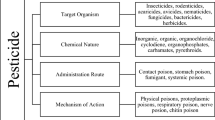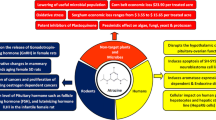Abstract
Based on the results of phenotypic features, phylogenetic similarity of 16S rRNA gene sequences and BIOLOG test, a soil bacterium was identified as Bacillus sp. DM-1. Using either growing cells or a cell-free extract, it transformed parathion and methyl parathion to amino derivatives by reducing the nitro group. Pesticide transformation by a cell-free extract was specifically inhibited by three nitroreductase inhibitors, indicating the presence of nitroreductase activity. The nitroreductase activity was NAD(P)H-dependent, O2-insensitive, and exhibited the substrate specificity for parathion and methyl parathion. Reductive transformation significantly decreased the toxicity of pesticides.


Similar content being viewed by others
References
Barton JW, Kuritz T, O’Connor LE, Ma CY, Maskarinec MP, Davison BH (2004) Reductive transformation of methyl parathion by the cyanobacterium Anabaena sp. strain PCC7120. Appl Microbiol Biotechnol 65:330–335
Bossche HV, Koymans L (1998) Cytochrome P450 in fungi. Mycoses 41:32–38
Bryant DW, McCalla DR, Leeksma M, Laneuville P (1981) Type I nitroreductases of Escherichia coli. Can J Microbiol 27:81–86
Chaudhry GR, Ali AN, Wheeler WB (1988) Isolation of a methyl parathion-degrading Pseudomonas sp. that possesses DNA homologous to the opd gene from a Flavobacterium sp. Appl Environ Microbiol 54:288–293
Esteve-Núňez A, Caballero A, Ramos JL (2001) Biological degradation of 2,4,6-trinitrotoluene. Microbiol Mol Biol Rev 65:335–352
Goronzy T, Drzyzga O, Kahl MW, Bruns-Nagel D, Breitung J, von Loew E, Blotevogel KH (1994) Microbial degradation of explosives and related compounds. Crit Rev Microbiol 20:265–284
Hawkins KI, Knittle CE (1972) Comparison of acetylcholinesterase determinations by the Michel and Ellman methods. Anal Chem 44:416–417
Holt JG, Krieg NR, Sneath PH, Staley JT, Williams ST (1994) Bergey’s manual of determinative bacteriology, 9th edn. Williams and Wilkins, Baltimore, MD
Koder RL, Miller AF (1998) Steady-state kinetic mechanism, stereospecifity, substrate and inhibitor specifity of Enterobacter cloacae nitroreductase. Biochim Biophys Acta 1387:395–405
Munnecke DM, Hsieh DPH (1976) Pathway of microbial metabolism of parathion. Appl Environ Microbiol 31:63–69
Rani NL, Lalithakumari D (1994) Degradation of methyl parathion by Pseudomonas putida. Can J Microbiol 40:1000–1006
Rosenberg A, Alexander M (1979) Microbial cleavage of various organophosphorus insecticides. Appl Environ Microbiol 37:886–891
Serdar CM, Gibson DT, Munnecke DM, Lancaster JH (1982) Plasmid involvement in parathion hydrolysis by Pseudomonas diminuta. Appl Environ Microbiol 44:246–249
Sethunathan N, Yoshida T (1973) Parathion degradation in submerged rice soils in the Philippines. J Agric Food Chem 21:504–506
Singh BK, Walker A (2006) Microbial degradation of organophosphorus compounds. FEMS Microbiol Rev 30:428–471
Spain JC (1995) Biodegradation of nitroaromatic compounds. Annu Rev Microbiol 49:523–555
Weisburg WG, Barns SM, Pelletier DA, Lane DJ (1991) 16S ribosomal DNA amplification for phylogenetic study. J Bacteriol 173:697–703
Zenno S, Kobori T, Tanokura M, Saigo K (1998) Purification and characterization of NfrA1, a Bacillus subtilis nitro/flavin reductase capable interacting with the bacterial luciferase. Biosci Biotechnol Biochem 62:1978–1987
Zenno S, Koike H, Kumar AK, Jayaraman R, Tanokura M, Saigo K (1996a) Biochemical characterization of NfsA, a Escherichia coli major nitroreductase exhibiting a high amino acid sequence homology to Frp, a Vibrio harveyi, flavin oxidoreductase. J Bacteriol 178:4508–4514
Zenno S, Koike H, Tanokura M, Saigo K (1996b) Gene cloning, purification, and characterization of NfsB, a minor oxygen-insensitive nitroreductase from Escherichia coli, similar in biochemical properties to FRaseI, the major flavin reductase in Vibrio fischeri. J Biochem 120:736–744
Acknowledgements
This work was supported by the 863 Hi-Tech Research and Development Program of the People’s Republic of China (No. 2005AA601020).
Author information
Authors and Affiliations
Corresponding author
Rights and permissions
About this article
Cite this article
Yang, C., Dong, M., Yuan, Y. et al. Reductive transformation of parathion and methyl parathion by Bacillus sp.. Biotechnol Lett 29, 487–493 (2007). https://doi.org/10.1007/s10529-006-9264-7
Received:
Revised:
Accepted:
Published:
Issue Date:
DOI: https://doi.org/10.1007/s10529-006-9264-7




